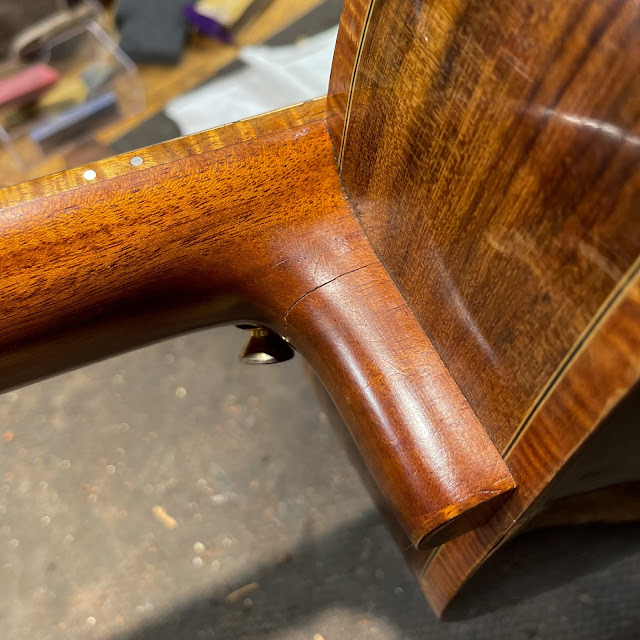Workshop: Bolted Neck Heel Crack Repair
Alright, so this beauteous $3000+ guitar has a heel crack after a drop. What's gone wrong?
Ah, bolts. It split along the line of that top bolt, of course. But... why?
After a stupid amount of struggling, I have the neck off and am holding it together as if it were installed. Those bolts are ginormous and...
...they fit into large "bullet" keepers. Two design elements are terrible, here, but are pretty typical for a lot of modern bolt-on neck designs that don't... get it.
The first design flaw is that there's a huge hole after the "bullet" mount that accepts the bolt. The bolt should have been cut-down to fit into the mount but not run into the wood behind it. That just weakens the already-small heel shape like crazy.
The second design flaw... is the bullet mount! That requires a lot of material to be removed from that small, endgrain-rippy mahogany tenon. It's neat that the builder fit-in some hardwood dowels with grain running in the opposite direction to stiffen the tenon... but it's just... too much material removed.
If I were building a bolt-on neck fresh I'd use the Gibson "coordinator rod" setup with a hanger-bolt installed and then a big hex nut fit inside the neck block area or I would just use a few drywall screws fit into the tenon from the neckblock "Fender-style" but tilted 90-degrees. I hate to see lots of wood removed from bolted heels. It's just a recipe for... this! ...to happen.
I'm not lecturing here, by the way -- most builders just don't build enough instruments in their lifetimes to ever know that these joints will fail like this. They take an idea used from someone else that seems like a good plan and then, if nothing ever gets abused, they would never know that it has weaknesses. As a repairman, I get to see all of the other similar joints which have failed like this.
That includes work from Taylor, Martin, Tacoma, and scads of other small-shop bolted-neck designs.
I'm not criticizing bolted necks, either -- I like them when they're done in a practical fashion. I think dovetails are silly and archaic. I can reset a modern Taylor neck in about 10-15 minutes. That's progress. The same can be said for '40s/'50s/'60s National "Stylist" necks and 1800s bolted/screw-adjustable necks. That's also progress. The KayKraft bolted/adjustable necks of the '30s are anti-progress, though, because they don't work. They look like a good idea but aren't. Just... like... this...
So... I plug the holes with dowels and epoxy the heck out of the break...
Here I've backfilled the voids with rosewood dust and am "setting" it with thin-viscosity superglue. It dries fast and makes like an instant-epoxy/glassy sort of fill. This trick only works well with oily woods... stuff like maple takes longer to set and so it's not as useful "in a pinch" like this.
Here I'm locating positions for my "new" neck bolts. The one closest to the fretboard is in a part of the heel that never broke. The bottom two are aligned away from previously-damaged areas.
Not only is the neck bolted (for stability/anchoring) but it's also now glued heavily with the joint shimmed-up tightly. It needs that because even with the repair that neck heel needs all the help it can get.

















Comments